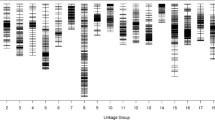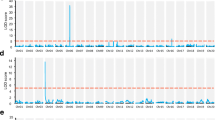Abstract
Understanding the transition to the reproductive period is important for crop breeding. This information can facilitate the production of novel varieties that are better adapted to local environments or changing climatic conditions. Here, we report the development of a high-density linkage map based on genotyping-by-sequencing (GBS) for the genus perilla. Through GBS library construction and Illumina sequencing of an F2 population, a total of 9607 single-nucleotide polymorphism (SNP) markers were developed. The ten-group linkage map of 1309.39 cM contained 2518 markers, with an average marker density of 0.56 cM per linkage group (LG). Using this map, a total of six QTLs were identified. These quantitative trait loci (QTLs) are associated with three traits related to flowering time: days to visible flower bud, days to flowering, and days to maturity. Ortholog analysis conducted with known genes involved in the regulation of flowering time among different crop species identified GI, CO and ELF4 as putative perilla orthologs that are closely linked to the QTL regions associated with flowering time. These results provide a foundation that will be useful for future studies of flowering time in perilla using fine mapping, and marker-assisted selection for the development of new varieties of perilla.


Similar content being viewed by others
References
Park Y-J, Dixit A, Ma K-H, Lee J-K, Lee M-H, Chung C-S, Nitta M, Okuno K, Kim T-S, Cho E-G, Rao VR (2007) Evaluation of genetic diversity and relationships within an on-farm collection of Perilla frutescens (L.) Britt. using microsatellite markers. Genet Resour Crop Evol 55(4):523–535. https://doi.org/10.1007/s10722-007-9258-x
Asif M (2011) Health effects of omega-3,6,9 fatty acids: Perilla frutescens is a good example of plant oils. Orient Pharm Exp Med 11(1):51–59. https://doi.org/10.1007/s13596-011-0002-x
Kim HU, Lee KR, Shim D, Lee JH, Chen GQ, Hwang S (2016) Transcriptome analysis and identification of genes associated with omega-3 fatty acid biosynthesis in Perilla frutescens (L.) var. frutescens. BMC Genom 17:474. https://doi.org/10.1186/s12864-016-2805-0
Msaada K, Hosni K, Taarit MB, Hammami M, Marzouk B (2009) Effects of growing region and maturity stages on oil yield and fatty acid composition of coriander (Coriandrum sativum L.) fruit. Scientia Horticulturae 120(4):525–531. https://doi.org/10.1016/j.scienta.2008.11.033
Ki Ichihara, Suda Y (2003) Lipid biosynthesis in developing perilla seeds. Phytochemistry 63(2):139–143. https://doi.org/10.1016/s0031-9422(03)00110-9
Vigeolas H, van Dongen JT, Waldeck P, Huhn D, Geigenberger P (2003) Lipid storage metabolism is limited by the prevailing low oxygen concentrations within developing seeds of oilseed rape. Plant Physiol 133(4):2048–2060. https://doi.org/10.1104/pp.103.031963
Kondo H, Ozaki H, Itoh K, Kato A, Takeno K (2006) Flowering induced by 5-azacytidine, a DNA demethylating reagent in a short-day plant Perilla frutescens var. crispa. Physiol Plant 127(1):130–137. https://doi.org/10.1111/j.1399-3054.2005.00635.x
Matsubara K, Hori K, Ogiso-Tanaka E, Yano M (2014) Cloning of quantitative trait genes from rice reveals conservation and divergence of photoperiod flowering pathways in Arabidopsis and rice. Front Plant Sci 5:193. https://doi.org/10.3389/fpls.2014.00193
Weller JL, Ortega R (2015) Genetic control of flowering time in legumes. Front Plant Sci 6:207. https://doi.org/10.3389/fpls.2015.00207
Song YH, Ito S, Imaizumi T (2013) Flowering time regulation: photoperiod- and temperature-sensing in leaves. Trends Plant Sci 18(10):575–583. https://doi.org/10.1016/j.tplants.2013.05.003
Tamaki S, Matsuo S, Wong HL, Yokoi S, Shimamoto K (2007) Hd3a protein is a mobile flowering signal in rice. Science 316(5827):1033–1036. https://doi.org/10.1126/science.1141753
Notaguchi M, Abe M, Kimura T, Daimon Y, Kobayashi T, Yamaguchi A, Tomita Y, Dohi K, Mori M, Araki T (2008) Long-distance, graft-transmissible action of Arabidopsis FLOWERING LOCUS T protein to promote flowering. Plant Cell Physiol 49(11):1645–1658. https://doi.org/10.1093/pcp/pcn154
Shim JS, Kubota A, Imaizumi T (2017) Circadian clock and photoperiodic flowering in Arabidopsis: CONSTANS is a hub for signal integration. Plant Physiol 173(1):5–15. https://doi.org/10.1104/pp.16.01327
Yamanaka N, Watanabe S, Toda K, Hayashi M, Fuchigami H, Takahashi R, Harada K (2005) Fine mapping of the FT1 locus for soybean flowering time using a residual heterozygous line derived from a recombinant inbred line. Theor Appl Genet 110(4):634–639. https://doi.org/10.1007/s00122-004-1886-3
Zhao XL, Shi ZY, Peng LT, Shen GZ, Zhang JL (2011) An atypical HLH protein OsLF in rice regulates flowering time and interacts with OsPIL13 and OsPIL15. N Biotechnol 28(6):788–797. https://doi.org/10.1016/j.nbt.2011.04.006
Nemoto Y, Kisaka M, Fuse T, Yano M, Ogihara Y (2003) Characterization and functional analysis of three wheat genes with homology to the CONSTANS flowering time gene in transgenic rice. Plant J 36(1):82–93
Kwak M, Velasco D, Gepts P (2008) Mapping homologous sequences for determinacy and photoperiod sensitivity in common bean (Phaseolus vulgaris). J Hered 99(3):283–291. https://doi.org/10.1093/jhered/esn005
Kim H-K, Cho Y-S, Yang J-W, Choi Y-W, Kang J-S, Lee Y-J, Son B-G (2010) Analysis of genetic variation of Perilla frutescens var. crispa germplasm using RAPD. J Life Sci 20(1):119–123. https://doi.org/10.5352/jls.2010.20.1.119
Lee MH, Yang KW, Ha TJ, Jung CS, Pae SB, Hwang CD, Park CH, Baek IY, Kim HK, Park SK (2011) Development of SCAR marker for identification of the Perilla species. Korean J Breed Sci 43(4):189–193
Kim Y, Kim AY, Jo A, Choi H, Cho SS, Choi C (2017) Development of user-friendly method to distinguish subspecies of the Korean medicinal herb Perilla frutescens using multiplex-PCR. Molecules 22(4):44. https://doi.org/10.3390/molecules22040665
Sa KJ, Choi SH, Ueno M, Park K-C, Park YJ, Ma KH, Lee JK (2013) Identification of genetic variations of cultivated and weedy types of Perilla species in Korea and Japan using morphological and SSR markers. Genes Genom 35(5):649–659. https://doi.org/10.1007/s13258-013-0117-1
Sa KJ, Choi SH, Ueno M, Lee JK (2015) Genetic diversity and population structure in cultivated and weedy types of Perilla in East Asia and other countries as revealed by SSR markers. Hortic Environ Biotechnol 56(4):524–534. https://doi.org/10.1007/s13580-015-0039-8
Sa KJ, Choi IY, Park KC, Lee JK (2018) Genetic diversity and population structure among accessions of Perilla frutescens (L.) Britton in East Asia using new developed microsatellite markers. Genes Genomics 40(12):1319–1329. https://doi.org/10.1007/s13258-018-0727-8
Woo SY, Sa KJ, Lee JK (2016) Collection and evaluation of genetic variation of perilla accessions in the Jeju Island. Plant Breeding and Biotechnology 4(1):87–98. https://doi.org/10.9787/pbb.2016.4.1.87
Liu L, Qu C, Wittkop B, Yi B, Xiao Y, He Y, Snowdon RJ, Li J (2013) A high-density SNP map for accurate mapping of seed fibre QTL in Brassica napus L. PLoS ONE 8(12):e83052. https://doi.org/10.1371/journal.pone.0083052
Eun MH, Han JH, Yoon JB, Lee J (2016) QTL mapping of resistance to the Cucumber mosaic virus P1 strain in pepper using a genotyping-by-sequencing analysis. Hortic Environ Biotechnol 57(6):589–597. https://doi.org/10.1007/s13580-016-0128-3
Poland JA, Brown PJ, Sorrells ME, Jannink JL (2012) Development of high-density genetic maps for barley and wheat using a novel two-enzyme genotyping-by-sequencing approach. PLoS ONE 7(2):e32253. https://doi.org/10.1371/journal.pone.0032253
Poland JA, Rife TW (2012) Genotyping-by-sequencing for plant breeding and genetics. Plant Genome J 5(3):92. https://doi.org/10.3835/plantgenome2012.05.0005
Deschamps S, Llaca V, May GD (2012) Genotyping-by-sequencing in plants. Biology (Basel) 1(3):460–483. https://doi.org/10.3390/biology1030460
Bielenberg DG, Rauh B, Fan S, Gasic K, Abbott AG, Reighard GL, Okie WR, Wells CE (2015) Genotyping by sequencing for SNP-based linkage map construction and QTL analysis of chilling requirement and bloom date in Peach [Prunus persica (L.) Batsch]. PLoS ONE 10(10):e0139406. https://doi.org/10.1371/journal.pone.0139406
Verma S, Gupta S, Bandhiwal N, Kumar T, Bharadwaj C, Bhatia S (2015) High-density linkage map construction and mapping of seed trait QTLs in chickpea (Cicer arietinum L.) using Genotyping-by-Sequencing (GBS). Sci Rep 5:17512. https://doi.org/10.1038/srep17512
Hussain W, Baenziger PS, Belamkar V, Guttieri MJ, Venegas JP, Easterly A, Sallam A, Poland J (2017) Genotyping-by-Sequencing derived high-density linkage map and its application to QTL mapping of flag leaf traits in bread wheat. Sci Rep 7(1):16394. https://doi.org/10.1038/s41598-017-16006-z
Li L, Zhao S, Su J, Fan S, Pang C, Wei H, Wang H, Gu L, Zhang C, Liu G, Yu D, Liu Q, Zhang X, Yu S (2017) High-density genetic linkage map construction by F2 populations and QTL analysis of early-maturity traits in upland cotton (Gossypium hirsutum L.). PLoS One 12(8):e0182918. https://doi.org/10.1371/journal.pone.0182918
Lee MH, Oh KW, Kim MS, Kim SU, Kim JI, Oh EY, Pae SB, Yeo US, Kim T-H, Lee JH, Jung CS, Kwak DY, Kim YC (2018) Detection of QTLs in an interspecific cross between Perilla citriodora × P hirtella mapping population. Korean J Breeding Sci 50(1):13–20. https://doi.org/10.9787/kjbs.2018.50.1.13
Allen GC, Flores-Vergara MA, Krasynanski S, Kumar S, Thompson WF (2006) A modified protocol for rapid DNA isolation from plant tissues using cetyltrimethylammonium bromide. Nat Protoc 1(5):2320–2325. https://doi.org/10.1038/nprot.2006.384
Elshire RJ, Glaubitz JC, Sun Q, Poland JA, Kawamoto K, Buckler ES, Mitchell SE (2011) A robust, simple genotyping-by-sequencing (GBS) approach for high diversity species. PLoS ONE 6(5):e19379. https://doi.org/10.1371/journal.pone.0019379
Martin M (2011) Cutadapt removes adapter sequences from high-throughput sequencing reads. EMBnet J 17(1):3. https://doi.org/10.14806/ej.17.1.200
Cox MP, Peterson DA, Biggs PJ (2010) SolexaQA: at-a-glance quality assessment of Illumina second-generation sequencing data. BMC Bioinform 11:485. https://doi.org/10.1186/1471-2105-11-485
Li H, Durbin R (2009) Fast and accurate short read alignment with Burrows–Wheeler transform. Bioinformatics 25(14):1754–1760. https://doi.org/10.1093/bioinformatics/btp324
Li H, Handsaker B, Wysoker A, Fennell T, Ruan J, Homer N, Marth G, Abecasis G, Durbin R, Genome Project Data Processing S (2009) The sequence alignment/map format and SAMtools. Bioinformatics 25(16):2078–2079. https://doi.org/10.1093/bioinformatics/btp352
Kim JE, Oh SK, Lee JH, Lee BM, Jo SH (2014) Genome-wide SNP calling using next generation sequencing data in tomato. Mol Cells 37(1):36–42. https://doi.org/10.14348/molcells.2014.2241
Meng L, Li H, Zhang L, Wang J (2015) QTL IciMapping: integrated software for genetic linkage map construction and quantitative trait locus mapping in biparental populations. Crop J 3(3):269–283. https://doi.org/10.1016/j.cj.2015.01.001
Lin S, Kernighan BW (1973) An effective heuristic algorithm for the Traveling-Salesman problem. Oper Res 21(2):498–516
Kosambi DD (1943) The estimation of map distances from recombination values. Ann Eugenic 12:172–175
Voorrips RE (2002) MapChart: software for the graphical presentation of linkage maps and QTLs. J Hered 93(1):77–78
Wang S, Basten CJ, Zeng ZB (2012) Windows QTL Cartographer 2.5. Department of Statistics, North Carolina State University, Raleigh, NC. (http://statgen.ncsu.edu/qtlcart/WQTLCart.htm)
Collard BCY, Jahufer MZZ, Brouwer JB, Pang ECK (2005) An introduction to markers, quantitative trait loci (QTL) mapping and marker-assisted selection for crop improvement: the basic concepts. Euphytica 142(1–2):169–196. https://doi.org/10.1007/s10681-005-1681-5
Stuber CW, Edwards MD, Wendel JF (1987) Molecular marker-facilitated investigations of quantitative trait loci in maize. II. Factors influencing yield and its component traits 1. Crop Sci 27(4):639–648. https://doi.org/10.2135/cropsci1987.0011183x002700040006x
Blumel M, Dally N, Jung C (2015) Flowering time regulation in crops-what did we learn from Arabidopsis? Curr Opin Biotechnol 32:121–129. https://doi.org/10.1016/j.copbio.2014.11.023
Kim WJ, Ryu J, Im J, Kim SH, Kang SY, Lee JH, Jo SH, Ha BK (2018) Molecular characterization of proton beam-induced mutations in soybean using genotyping-by-sequencing. Mol Genet Genomics 293(5):1169–1180. https://doi.org/10.1007/s00438-018-1448-z
SuaÂrez-LoÂpez P, Wheatley K, Robson F, Onouchi H, Valverde F, George C (2001) CONSTANS mediates between the circadian clock and the control of flowering in Arabidopsis. Nature 410(6832):1116–1120. https://doi.org/10.1038/35074138
Imaizumi T, Schultz TF, Harmon FG, Ho LA, Kay SA (2005) FKF1 F-box protein mediates cyclic degradation of a repressor of CONSTANS in Arabidopsis. Science 309(5732):293–297. https://doi.org/10.1126/science.1110586
Sawa M, Nusinow DA, Kay SA, Imaizumi T (2007) FKF1 and GIGANTEA complex formation is required for day-length measurement in Arabidopsis. Science 318(5848):261–265. https://doi.org/10.1126/science.1146994
Fornara F, Panigrahi KC, Gissot L, Sauerbrunn N, Ruhl M, Jarillo JA, Coupland G (2009) Arabidopsis DOF transcription factors act redundantly to reduce CONSTANS expression and are essential for a photoperiodic flowering response. Dev Cell 17(1):75–86. https://doi.org/10.1016/j.devcel.2009.06.015
Kim Y, Lim J, Yeom M, Kim H, Kim J, Wang L, Kim WY, Somers DE, Nam HG (2013) ELF4 regulates GIGANTEA chromatin access through subnuclear sequestration. Cell Rep 3(3):671–677. https://doi.org/10.1016/j.celrep.2013.02.021
Cao D, Li Y, Lu S, Wang J, Nan H, Li X, Shi D, Fang C, Zhai H, Yuan X, Anai T, Xia Z, Liu B, Kong F (2015) GmCOL1a and GmCOL1b function as flowering repressors in soybean under long-day conditions. Plant Cell Physiol 56(12):2409–2422. https://doi.org/10.1093/pcp/pcv152
Kojima S, Takahashi Y, Kobayashi Y, Monna L, Sasaki T, Araki T, Yano M (2002) Hd3a, a rice ortholog of the Arabidopsis FT gene, promotes transition to flowering downstream of Hd1 under short-day conditions. Plant Cell Physiol 43(10):1096–1105
Yano M, Katayose Y, Ashikari M, Yamanouchi U, Monna L, Fuse T, Baba T, Yamamoto K, Umehara Y, Nagamura Y, Sasaki T (2000) Hd1, a major photoperiod sensitivity quantitative trait locus in rice, is closely related to the Arabidopsis flowering time gene CONSTANS. Plant Cell 12(12):2473–2484
Cao D, Takeshima R, Zhao C, Liu B, Jun A, Kong F (2017) Molecular mechanisms of flowering under long days and stem growth habit in soybean. J Exp Bot 68(8):1873–1884. https://doi.org/10.1093/jxb/erw394
Acknowledgements
This work was supported by a Grant from the National Agricultural Genome Project (Nos. PJ01040803, PJ01335503), Rural Development Administration, Republic of Korea.
Author information
Authors and Affiliations
Contributions
YJ, BM, SH, and JH conceived and designed the experiments; YJ and BM conducted the SNP analysis, linkage map construction, and data analysis; MN constructed the GBS library; KW and MH developed the mapping population and evaluated the plant phenotypes; TH provided the draft genome and participated in discussions about the experiments; YJ, SH and JH wrote the manuscript; and SH and JH reviewed the manuscript.
Corresponding authors
Ethics declarations
Conflict of interest
On behalf of all authors, the corresponding author states that there is no conflict of interest.
Additional information
Publisher's Note
Springer Nature remains neutral with regard to jurisdictional claims in published maps and institutional affiliations.
Electronic supplementary material
Below is the link to the electronic supplementary material.
Supplementary material 1 (PNG 5004 kb)
Fig. S1 Frequency distributions. The frequency distributions of three flowering-related traits in the 96 studied F2 populations of the parental lines P. citriodora x P. hiretella. The values corresponding to the parental lines (PLs) are shown by the vertical line. A: days to visible flower bud; B: days to flowering; C: days to maturity.
Rights and permissions
About this article
Cite this article
Kang, YJ., Lee, BM., Nam, M. et al. Identification of quantitative trait loci associated with flowering time in perilla using genotyping-by-sequencing. Mol Biol Rep 46, 4397–4407 (2019). https://doi.org/10.1007/s11033-019-04894-5
Received:
Accepted:
Published:
Issue Date:
DOI: https://doi.org/10.1007/s11033-019-04894-5




